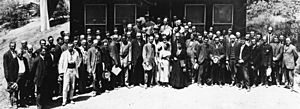Alfred Fowler facts for kids
Quick facts for kids
Alfred Fowler
|
|
|---|---|
 |
|
| Born | 22 March 1868 Yorkshire, England
|
| Died | 24 June 1940 (aged 72) |
| Awards | Valz Prize (1913) Gold Medal of the Royal Astronomical Society (1915) Royal Medal (1918) Henry Draper Medal (1920) Bruce Medal (1934) |
| Scientific career | |
| Fields | Astronomy |
Alfred Fowler (born March 22, 1868, died June 24, 1940) was an English astronomer. He was also a spectroscopist, which means he studied light to understand what things are made of. He was known for his important work on how light from stars and the Sun can tell us about them.
Contents
Discovering the Universe with Light
Alfred Fowler was born in Wilsden, a town in Yorkshire, England. He studied at the Normal School of Science in London. This school later became part of Imperial College, London.
Fowler's Work at Imperial College
Fowler became a professor of Astrophysics at Imperial College. He worked there for his entire career. He was very good at spectroscopy. This science looks at the different colors of light that objects give off. These colors can tell us what elements are in the object.
One of his big discoveries was about sunspots. Sunspots are dark areas on the Sun's surface. Fowler was one of the first to figure out that sunspots are cooler than the areas around them.
Joining the Royal Society
In 1910, Alfred Fowler became a Fellow of the Royal Society. This is a very important group for scientists. They recognized him for his work in astronomical physics. This included his observations of solar eclipses and sunspots. He also did experiments to understand what he saw.
He worked with other famous scientists like Norman Lockyer on solar eclipses. Fowler received the Royal Medal in 1918 for his scientific achievements.
Fowler also led the Royal Astronomical Society as its president from 1919 to 1921. He passed away in Ealing, London in 1940.

The Pickering–Fowler Series
Alfred Fowler was involved in a very important discovery about light from stars. In 1896, another astronomer, Edward Charles Pickering, saw some new lines in the light spectrum of a star called Zeta Puppis. He thought these lines came from hydrogen.
Unraveling the Mystery of Light
In 1912, Fowler did an experiment. He mixed hydrogen and helium gases. He was able to create the same light lines that Pickering had seen. At first, Fowler agreed with Pickering that these lines were from hydrogen. These special lines became known as the Pickering–Fowler series.
However, a famous scientist named Niels Bohr studied these lines. He used his new ideas about how atoms work. Bohr figured out that the lines were actually from ionized helium (He+), not hydrogen. Ionized helium is a helium atom that has lost one of its electrons.
A New Understanding of Atoms
Fowler was not sure at first, but he eventually agreed that Bohr was right. By 1915, other scientists also agreed. This discovery was very important. It showed that Bohr's new theory about atoms was correct. It also made scientists look again at things they thought they already understood. This helped us learn a lot more about the tiny parts that make up everything around us.
Awards and Recognition
Alfred Fowler received many awards for his important work:
- Valz Prize from the French Academy of Sciences (1913)
- Gold Medal of the Royal Astronomical Society (1915)
- Royal Medal (1918)
- Henry Draper Medal from the National Academy of Sciences (1920)
- Bruce Medal (1934)
- He was also made a Commander of the Most Excellent Order of the British Empire (1935).
Named After Him
- A crater on the Moon is named Fowler. It is named after both Alfred Fowler and another scientist, Ralph H. Fowler.

